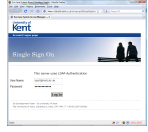Enterprise password management really isn't a good idea


Although a university is a good example of an enterprise, it can work in any existing enterprise system. Whilst the consumer product has been named Editor's Choice by PC Magazine and CNET Software of the Year, I've been playing with the enterprise software in a virtual environment and it's good.
RoboForm Enterprise converts passwords from websites, Intranet domains and suchlike into passcards, which then stored securely, are used by your browser to fill in login information. It can save information from registration details or common identity text - such as billing/shipping addresses into identities. Not only that, it can secure snippets of secure information such as ATM and cash machine PIN codes, safe combination locks and secure entry door lock codes into what they call safenotes.
Because it works on Windows, it automatically works with Internet Explorer 6 and above, but gives the option to work with Firefox which is another great part of the software. They recognise that many organisations use Firefox as an alternative, and include that functionality with their own software. One "problem" that may arise is because either Mozilla update Firefox too much, or RoboForm don't update their own software enough, it may not work with your Firefox version. I run Firefox 3.0.1 and the RoboForm software only works with major editions - Firefox 1.5 - 3.0, and presumably upwards to 3.1 when it eventually comes out, but nothing minor in-between.
The program does work well though; you enter your username and password for any website, click "Save" in the toolbar, and then login as usual. Once you reach that page again, it'll tell you that you've saved data and can simply click a button to fill in the information for you. From a press release emailed to me:
RoboForm Enterprise lets companies implement a low-risk, cost effective, easy and secure password management solution. IT Managers can completely customize RoboForm Enterprise within 15 minutes to meet the company’s password policies.
Employees enjoy the same advantages RoboForm offers consumers, but within the corporate setting: they can securely store usernames and passwords, log into web applications automatically, and complete long web forms with one click. Users no longer have to remember a long list of passwords for different sites, rely on the web browser to keep the passwords, write their passwords down, or list them in files on their computer—none of which is secure.
Because it is designed for the client machine and therefore, the client, you can set a master password for all of your other identities and passcards. There is, however, a danger of forgetting your passwords. Let me explain.
One of my old colleagues used a password manager. It'd remember her passwords for her and she only had to type them in once. After that, they'd automatically fill the boxes for that particular domain and it'd be a piece of cake for her. Then when she decided to do some work in Starbucks round the corner, she spilt her coffee all over her laptop thus killing it. The laptop was backup to the central server store the night before, but her passwords were all saved on that computer... and forgot what her passwords were for each website, because she was so used to not using them.
Some issues I'm still not happy with:
- The user interface isn't too great, and seems a bit too "playful" for serious enterprise software.
- It may increase security but passwords can still be forgotten.
- Regardless of how secure their encryption might be, there will always be a way to crack it, even though it's still highly unlikely. For the time being, I'm happy keeping passwords in my head because I know my "brain encryption" can't be broken into by anybody.
- It saves the safenotes, passcards and identities on the local computer. Although I'm sure this can be changed, it's still not ideal in hot-desking environments or those without roaming user profiles.
- It's expensive and an actual single sign-on server or utility using the LDAP protocol may be more efficient.
- IT administrators and network security personnel, especially those on high-security or internal government networks would most likely prefer to be asked to reset a password every 5 minutes than to have a potentially vulnerable file full of passwords to be ripped out by a computer virus and sent somewhere.
It's not for me, and it may have its merits - but head for a single sign-on (SSO) feature in your network than an enterprise password manager, because something inevitably will go horribly wrong.
*hits uninstall*